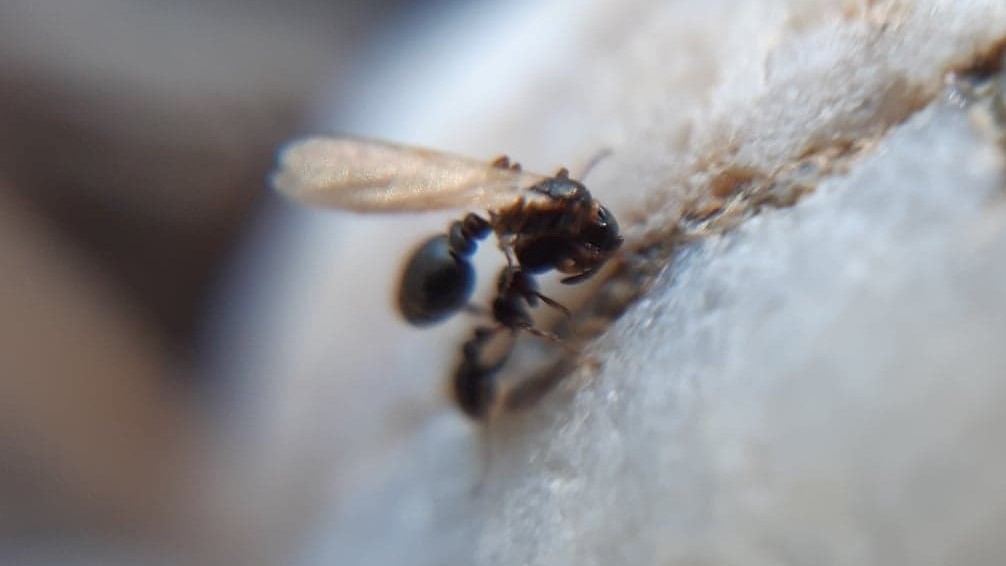These worker ants drag their queens to far-off bachelor pads to mate
The matchmaking service is a tactic to avoid inbreeding.

Worker ants are known to take on many different job roles, from trash collectors to nurses that dress the wounds of injured comrades, to babysitters that care for their leader's young. But one Mediterranean ant species takes royal work to the extreme: The worker ants use their mandibles to haul their young queen to faraway nests so she can mate, according to new research.
Despite their miniscule size — around 0.1 inch (2 to 3 millimeters) — Cardiocondyla elegans ant workers have been observed carrying queens up to 50 feet (15 meters) from their home nests and dropping them off outside neighboring colonies. (That's about 5,500 times the ant's body length. If a 5-foot-tall (1.5 meters) person made the equivalent journey, they'd cover 27,500 feet, or more than 8,300 m.)
Scientists think that this piggybacking of queens to distant nests is the first recorded case of third-party matchmaking in animals; and it's all to avoid inbreeding.
Related: Gallery of crazy ants
"They need genetic diversity in order to survive," lead author Mathilde Vidal, a doctoral student at the University of Regensburg in Germany, told Live Science. "In other species, the male ants can just fly away, but here the males don't have wings and the queens won't use their wings. Neither will the queens leave the nests by themselves — it's up to the workers to carry them out."
Between 2014 and 2019, Vidal and her colleagues mapped out 175 Cardiocondyla elegans ant colonies across southern France; they observed how the worker ants carry the queens by gripping them firmly in their mandibles and hauling them on their backs, only releasing the queen once outside a foreign nest.
After a queen has been deposited outside, the researchers found, she is permitted entry to the mating chamber, located near the nest entrance and filled with males — all of which are confined inside the chamber and accustomed to mating with closely related females. The outside queen then mates with the male ants, storing their sperm in a sac called a spermatheca for the rest of her life.
Get the world’s most fascinating discoveries delivered straight to your inbox.
Once the queen has successfully mated, she spends the winter in the foreign nest before being booted out in the spring to start her own colony, the researchers discovered. This behavior could be related to the ants' strict rules regarding resource allocation. It may be in the interest of a colony to look after a foreign queen that is carrying their genes, but workers will not tolerate more than one resource-intensive, egg-laying queen in a nest for too long; the workers can often become hostile, even murderous, to any queen that outstays her welcome.
But the ant queen's story doesn't always end there. The researchers believe that some young queens get carried to multiple colonies by worker ants from different nests, mating with males from all of them.
"In a nest with a lot of new queens to send out, the chances are that a worker will occasionally pick up an alien queen," said Vidal.
Among most ant species, excessive inbreeding is usually counteracted through nuptial flights — single summer-day events during which winged males and females will take flight to breed in large swarms. But Cardiocondyla elegans' males are wingless and their queens' wings appear to be largely vestigial. So, in order to ensure a healthy mixing of genes, and a prudent scattering of relatives across their capricious and flood-prone riverbank habitat, workers must lend a helping mandible.
"Around 40% of the colonies can die every year," Vidal said of this particular species. "If they want to make sure their genes survive, they have to make sure they're well spread out."
Yet even with these zealous redistribution efforts, inbreeding still plays a vital role in the ants' reproductive cycles. Genetic experiments have revealed that two-thirds of all Cardiocondyla matings are between close relatives.
"These queens tend to mate with around eight males in their lives, four of whom, on average, are brothers," Vidal said. "Those other four can come from multiple colonies, but we don't know how many they're taken to on average yet."
Mysteries remain, such as what causes queen-laden worker ants to skip nearer nests in favor of those farther away, or what other rules could be governing workers' decisions on where they leave their queens. Answers to these questions could remain elusive until the researchers find a way to make the ants perform the carrying behavior in a lab environment. Still, the research highlights an interesting, seldom-observed fact about ant societies, and all societies in general: Rulers are as much an instrument of the ruled as the ruled are of rulers, and are dispensed with swiftly once they outlive their usefulness.
The researchers published their findings May 3 in the journal Communications Biology.
Originally published on Live Science.

Ben Turner is a U.K. based writer and editor at Live Science. He covers physics and astronomy, tech and climate change. He graduated from University College London with a degree in particle physics before training as a journalist. When he's not writing, Ben enjoys reading literature, playing the guitar and embarrassing himself with chess.


